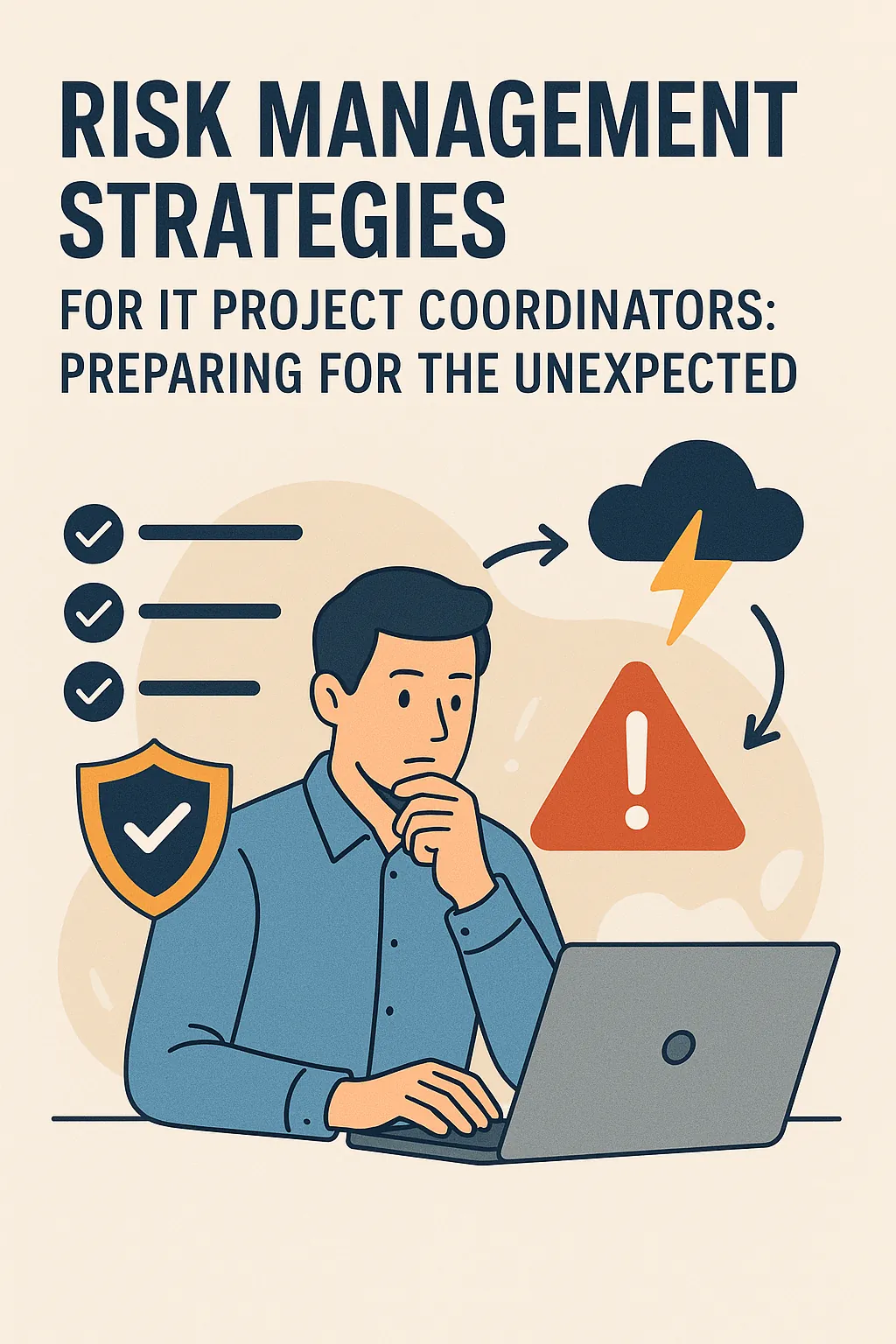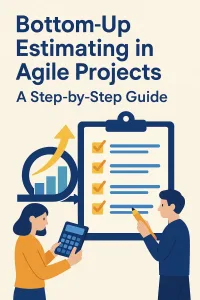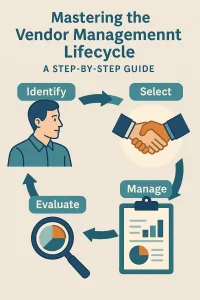Introduction
The role of an IT project coordinator is pivotal. These professionals serve as the linchpin between various stakeholders, ensuring that projects are executed smoothly, on time, and within budget. An IT project coordinator is responsible for overseeing project timelines, managing resources, and facilitating communication among team members. Their ability to navigate the complexities of technology projects is essential for achieving project objectives and delivering value to the organization.
One of the most critical aspects of an IT project coordinator’s responsibilities is risk management. Given the inherent uncertainties in IT projects—ranging from technical challenges to shifting stakeholder expectations—effective risk management is not just beneficial; it is essential. By identifying potential risks early in the project lifecycle, coordinators can develop strategies to mitigate these risks, thereby safeguarding the project’s success. This proactive approach helps to minimize disruptions, avoid costly delays, and ensure that project goals are met.
Proactive risk management involves anticipating potential issues before they arise and implementing measures to address them. This strategy is particularly important in the fast-paced world of IT, where changes can occur rapidly and unexpectedly. By fostering a culture of continuous risk assessment and monitoring, IT project coordinators can ensure that their teams are prepared to adapt to challenges as they emerge. This not only enhances the likelihood of project success but also builds resilience within the project team, enabling them to respond effectively to unforeseen circumstances.
Understanding Risks in IT Projects
Understanding the various risks that can arise is crucial for project coordinators and risk managers. By identifying these risks early, teams can implement proactive measures to mitigate their impact, ensuring smoother project execution and successful outcomes.
Types of Risks Specific to IT Projects
- Technical Risks: These include issues related to technology failures, software bugs, and integration challenges. For instance, a new software tool may not integrate well with existing systems, leading to delays and additional costs.
- Organizational Risks: These risks stem from internal factors such as resource allocation, team dynamics, and stakeholder engagement. A lack of clear communication or misalignment among team members can hinder project progress.
- External Risks: External factors such as regulatory changes, market fluctuations, or vendor reliability can significantly impact IT projects. For example, a sudden change in compliance requirements may necessitate unplanned adjustments to the project scope.
Impact of Risks on Project Timelines, Budgets, and Outcomes
The consequences of unmanaged risks can be severe, affecting various aspects of project management:
- Timelines: Delays caused by unforeseen technical issues or resource shortages can push project deadlines back, leading to missed launch dates and potential revenue loss.
- Budgets: Unanticipated costs arising from risk events can strain project budgets. For instance, if a project requires additional resources to address a technical failure, it may exceed its initial financial projections.
- Outcomes: Ultimately, unmanaged risks can compromise the quality of the final product. If a project is rushed to meet deadlines due to previous delays, it may result in a subpar deliverable that fails to meet user expectations.
Statistics and Case Studies
Statistics highlight the importance of effective risk management in IT projects. Research indicates that projects with robust risk management practices are 30% more likely to succeed compared to those without such measures in place. Additionally, a study found that 70% of IT projects experience scope creep, often due to unmanaged risks, which can lead to significant budget overruns and project failure.
A notable case study involves a large-scale software implementation for a financial institution. The project faced numerous technical risks, including integration issues with legacy systems. Without a proactive risk management strategy, the project experienced a 25% increase in costs and a six-month delay in delivery. This case underscores the critical need for IT project coordinators to identify and address risks early in the project lifecycle.
By understanding the types of risks specific to IT projects and their potential impacts, project coordinators can better prepare for the unexpected, ensuring that their projects remain on track and within budget. Implementing effective risk management strategies not only enhances project success rates but also fosters a culture of proactive problem-solving within teams.
Proactive Risk Identification Techniques
The ability to identify risks early is crucial for ensuring project success. IT project coordinators play a vital role in this process, and employing proactive risk identification techniques can significantly enhance their effectiveness. Here are several strategies that can be utilized to identify potential risks before they escalate:
- Brainstorming Sessions and Expert Interviews: Engaging team members in brainstorming sessions can foster a collaborative environment where diverse perspectives are shared. This technique encourages open dialogue about potential risks, allowing team members to voice concerns and insights that may not be immediately apparent. Additionally, conducting interviews with subject matter experts can provide valuable insights into specific areas of the project that may be prone to risks. Experts can highlight past experiences and lessons learned, which can inform the risk identification process [1][2].
- Utilization of Checklists: Implementing checklists is a practical approach to ensure that no potential risk is overlooked. Checklists can be tailored to the specific project and its unique challenges, serving as a comprehensive guide for project coordinators. By systematically reviewing each item on the checklist, coordinators can identify risks related to project scope, resources, timelines, and technology. This method not only aids in risk identification but also promotes consistency in the risk management process [5][10].
- Historical Data Analysis: Analyzing historical data from previous projects can provide invaluable insights into common risks and their impacts. By reviewing past project outcomes, IT project coordinators can identify patterns and trends that may indicate potential risks in current projects. This data-driven approach allows for a more informed risk assessment, enabling coordinators to anticipate issues based on historical precedents [3][12].
- Importance of Stakeholder Feedback: Engaging stakeholders throughout the project lifecycle is essential for identifying potential risks. Stakeholders often have unique insights and experiences that can highlight risks that project teams may not consider. Regularly soliciting feedback from stakeholders can help project coordinators stay informed about any concerns or changes in the project environment that could introduce new risks. This collaborative approach not only enhances risk identification but also fosters a sense of ownership and accountability among stakeholders [9][14].
By implementing these proactive risk identification techniques, IT project coordinators can better prepare for the unexpected, ultimately leading to more successful project outcomes. Emphasizing early identification and collaboration will empower coordinators to navigate the complexities of IT projects with greater confidence and resilience.
Risk Assessment and Prioritization
Effective risk assessment and prioritization are crucial for ensuring project success. IT project coordinators must adopt proactive measures to identify and mitigate risks, thereby preparing for the unexpected. This section will delve into the methodologies for assessing risks, introduce useful tools, and emphasize the importance of prioritizing risks based on their potential impact and likelihood.
Qualitative vs. Quantitative Risk Assessment Methods
Risk assessment can be approached through two primary methodologies: qualitative and quantitative.
- Qualitative Risk Assessment: This method involves subjective evaluation of risks based on their characteristics. It typically uses descriptive scales to categorize risks as high, medium, or low. Qualitative assessments are beneficial for quickly identifying potential risks and understanding their implications without extensive data analysis. This approach is particularly useful in the early stages of project planning when detailed data may not be available [10].
- Quantitative Risk Assessment: In contrast, quantitative risk assessment employs numerical data to evaluate risks. This method involves statistical analysis to estimate the probability of risks occurring and their potential impact on project objectives. Techniques such as Monte Carlo simulations or decision tree analysis can be utilized to provide a more precise understanding of risks. Quantitative assessments are essential for projects with significant financial implications, as they allow for more informed decision-making [10][11].
Tools for Risk Assessment
To facilitate effective risk assessment, IT project coordinators can utilize various tools:
- Risk Matrices: A risk matrix is a visual tool that helps in categorizing risks based on their likelihood of occurrence and potential impact. By plotting risks on a matrix, coordinators can easily identify which risks require immediate attention and which can be monitored over time [7].
- Probability-Impact Charts: Similar to risk matrices, probability-impact charts provide a graphical representation of risks. They allow project teams to assess risks by plotting their probability against their impact, helping to visualize the most critical risks that could affect project outcomes [7][8].
These tools not only streamline the risk assessment process but also enhance communication among stakeholders by providing a clear visual representation of risks.
Significance of Prioritizing Risks
Prioritizing risks is a fundamental aspect of risk management. By assessing risks based on their potential impact and likelihood, IT project coordinators can focus their resources and efforts on the most significant threats to project success.
- Impact Assessment: Understanding the potential consequences of a risk is vital. High-impact risks can lead to project delays, increased costs, or even project failure. By prioritizing these risks, coordinators can develop targeted mitigation strategies to address them effectively [12][14].
- Likelihood Evaluation: Alongside impact, the probability of a risk occurring must also be considered. Risks that are both highly likely and have severe consequences should be prioritized for immediate action. This dual focus ensures that project teams are not only prepared for potential issues but are also allocating resources efficiently [9][14].
Developing Risk Mitigation Strategies
Risk is an inevitable factor that can significantly impact project outcomes. For IT project coordinators, developing effective risk mitigation strategies is crucial to ensure project success. Here, we outline various approaches to risk mitigation, provide specific examples relevant to IT projects, and emphasize the importance of creating contingency plans.
Approaches to Risk Mitigation
- Risk Avoidance: This strategy involves altering project plans to eliminate risks or protect project objectives from their impact. For instance, if a particular technology is known to be unstable, a project coordinator might choose to adopt a more reliable technology instead.
- Risk Transfer: This approach shifts the risk to a third party, often through contracts or insurance. For example, an IT project might involve outsourcing certain components to a vendor, thereby transferring the risk of delays or failures associated with that component to the vendor.
- Risk Acceptance: Sometimes, the best course of action is to accept the risk when the costs of mitigation are higher than the risk itself. For instance, if a minor software bug is identified that does not significantly affect functionality, the project team may decide to accept the risk and address it in a future update.
- Risk Reduction: This strategy aims to reduce the impact or likelihood of risks. For example, implementing regular code reviews and testing can help identify potential issues early in the development process, thereby reducing the risk of major failures later on.
Examples of Mitigation Strategies Specific to IT Projects
- Regular Risk Assessments: Conducting frequent risk assessments throughout the project lifecycle allows project coordinators to identify new risks and adjust mitigation strategies accordingly. This proactive approach ensures that risks are managed continuously rather than reactively.
- Stakeholder Engagement: Involving stakeholders in the risk management process can provide valuable insights and help identify potential risks that may not be apparent to the project team. Regular communication with stakeholders can also facilitate quicker responses to emerging risks.
- Training and Development: Providing training for team members on risk management practices can enhance the team’s ability to identify and respond to risks effectively. This could include workshops on risk assessment techniques or tools for monitoring project progress.
Importance of Creating Contingency Plans
Contingency plans are essential for managing risks effectively. These plans outline the steps to be taken if a risk materializes, ensuring that the project team is prepared to respond swiftly and effectively. Key reasons for developing contingency plans include:
- Preparedness: Having a well-defined contingency plan allows the project team to act quickly in the event of an unexpected issue, minimizing disruption to the project timeline.
- Resource Allocation: Contingency plans help in identifying the resources required to address potential risks, ensuring that the project team is not caught off guard.
- Stakeholder Confidence: Demonstrating a proactive approach to risk management through contingency planning can enhance stakeholder trust and confidence in the project team’s ability to deliver successful outcomes.
Implementing and Monitoring Risk Management Plans
The role of an IT project coordinator is pivotal, especially when it comes to risk management. As projects evolve, the landscape of potential risks can shift dramatically, making it essential for coordinators to adopt proactive measures to identify and mitigate these risks effectively. Here are some key strategies for implementing and monitoring risk management plans:
Importance of Regular Risk Reviews and Updates
Regular risk reviews are crucial for maintaining an effective risk management strategy. By conducting these reviews, IT project coordinators can:
- Identify New Risks: As projects progress, new risks may emerge due to changes in technology, team dynamics, or external factors. Regular reviews help in recognizing these risks early on, allowing for timely intervention [1].
- Assess Existing Risks: The impact and likelihood of previously identified risks can change over time. Regular updates ensure that the risk assessment remains relevant and accurate, enabling coordinators to prioritize their responses effectively [4].
- Adapt Strategies: Continuous monitoring allows project teams to adapt their risk management strategies based on the latest information, ensuring that they remain effective in mitigating risks [15].
Tools for Monitoring Risks
Utilizing the right tools can significantly enhance the effectiveness of risk management efforts. Some essential tools include:
- Dashboards: These provide a visual representation of risk data, allowing project coordinators to quickly assess the status of various risks and their potential impact on the project. Dashboards can be customized to highlight key performance indicators related to risk management [3].
- Risk Registers: A risk register is a comprehensive document that lists all identified risks, their assessments, and the strategies in place to mitigate them. Keeping this document updated is vital for tracking the progress of risk management efforts and ensuring accountability within the project team [11].
The Role of Communication
Effective communication is a cornerstone of successful risk management. IT project coordinators should prioritize keeping stakeholders informed about risks through:
- Regular Updates: Providing stakeholders with consistent updates on risk status fosters transparency and builds trust. This can be achieved through scheduled meetings or reports that outline current risks and the measures being taken to address them [2][8].
- Engagement Strategies: Actively involving stakeholders in the risk management process encourages collaboration and can lead to more comprehensive risk identification. This engagement can be facilitated through workshops or brainstorming sessions focused on risk assessment [5][9].
Case Studies: Successful Risk Management in IT Projects
The ability to anticipate and mitigate risks is crucial for ensuring project success. This section presents several case studies that exemplify effective risk management strategies employed by IT project coordinators. By analyzing these real-world examples, we can derive valuable lessons and best practices that can be applied to future projects.
Case Study 1: Telecommunications Project
One notable case study involved a telecommunications project where the project team faced significant risks related to technology integration and regulatory compliance. The project coordinators implemented a proactive risk management strategy that included:
- Risk Identification Workshops: The team conducted workshops to identify potential risks early in the project lifecycle. This collaborative approach ensured that all stakeholders contributed to the risk identification process, leading to a comprehensive risk register.
- Regular Risk Assessments: The project coordinators scheduled regular assessments to evaluate the status of identified risks and to identify new risks as the project progressed. This ongoing monitoring allowed the team to adapt their strategies in real-time.
- Mitigation Plans: For each identified risk, the team developed detailed mitigation plans that outlined specific actions to reduce the likelihood of occurrence or impact. This included contingency plans for critical risks.
Lessons Learned: The project highlighted the importance of continuous communication among stakeholders and the need for flexibility in risk management strategies. By maintaining open channels of communication, the team was able to respond swiftly to emerging risks, ultimately leading to project success [2][14].
Case Study 2: Software Development Project
In another case, a software development project faced challenges related to scope creep and resource allocation. The project coordinators employed several proactive measures:
- Stakeholder Engagement: Early engagement with stakeholders helped clarify project objectives and expectations, reducing the likelihood of scope changes later in the project.
- Agile Methodology: By adopting an agile approach, the project team was able to iterate quickly and respond to changes in requirements. This flexibility allowed them to manage risks associated with evolving project needs effectively.
- Resource Management Tools: The use of resource management tools enabled the project coordinators to allocate resources efficiently and identify potential bottlenecks before they became critical issues.
This case study underscored the value of stakeholder involvement and the benefits of agile methodologies in managing risks. Engaging stakeholders early and often can help align project goals and minimize misunderstandings that lead to risks [13][15].
Case Study 3: Infrastructure Upgrade Project
A third case study focused on an infrastructure upgrade project that encountered risks related to vendor reliability and technology obsolescence. The project coordinators took the following proactive steps:
- Vendor Assessment: The team conducted thorough assessments of potential vendors, including their financial stability and past performance. This due diligence helped mitigate risks associated with vendor reliability.
- Technology Roadmapping: By creating a technology roadmap, the project team was able to anticipate future technology needs and plan for upgrades, reducing the risk of obsolescence.
- Contingency Planning: The project included contingency plans for critical components, ensuring that alternative solutions were available if primary vendors failed to deliver.
This project demonstrated the importance of thorough vendor assessments and strategic planning in risk management. By anticipating potential issues and preparing for them, the project coordinators were able to navigate challenges effectively and keep the project on track [10][11][15].
Summary of Key Takeaways
The analysis of these case studies reveals several key takeaways for IT project coordinators:
- Proactive Risk Identification: Engaging stakeholders and conducting regular risk assessments are essential for identifying potential risks early.
- Flexible Strategies: Adopting agile methodologies and maintaining flexibility in risk management approaches can help teams respond effectively to changing project dynamics.
- Thorough Planning: Comprehensive vendor assessments and technology roadmapping are critical for mitigating risks associated with external dependencies and technological changes.
By implementing these strategies, IT project coordinators can enhance their ability to manage risks proactively, ultimately leading to more successful project outcomes.
Conclusion
The significance of identifying and mitigating risks cannot be overstated. Effective risk management is essential for ensuring that projects remain on track, within budget, and aligned with their intended outcomes. By proactively addressing potential threats, IT project coordinators can significantly reduce the likelihood of disruptions and enhance the overall success of their projects. This proactive approach not only safeguards project timelines but also fosters a culture of preparedness within teams, enabling them to navigate challenges with confidence.
IT project coordinators are encouraged to adopt a proactive risk management mindset. This involves not only recognizing the various types of risks that may arise but also implementing robust strategies to mitigate them. By conducting regular risk assessments, establishing clear communication channels, and fostering a risk-aware culture among team members, coordinators can create an environment where risks are anticipated and managed effectively. Such a mindset empowers teams to respond swiftly to unforeseen challenges, ultimately leading to more successful project outcomes.
Find out more about Shaun Stoltz https://www.shaunstoltz.com/about/.
This post was written by an AI and reviewed/edited by a human.



